Are you a Quiet Speculation member?
If not, now is a perfect time to join up! Our powerful tools, breaking-news analysis, and exclusive Discord channel will make sure you stay up to date and ahead of the curve.
Okay, true confession time: the fact that I even have selected this topic to write about today indicates that there is a substantial enough sentiment in the community towards the negative. After all, if I pitched the concept as "Why Primeval Titan Matters" or even the daring "Why Standard Matters" one might hardly feel inclined to read it. "Prima facie," one might disdainfully mutter, before clicking onto far more substantive fare such as Living the Dream: Going Infinite or What Coverage Can Do for the Casual You.
But no, not the lowly intro pack deck! Alas, our beleagured friend must from time to time remind players why it is relevant, what it does, and why that even matters! But even our readers from the jaded wing might find some surprising answers within that humble, $12.99 package. Who knew, for example, that to a certain extent these preconstructed decks need to be bad to be good? And who might guess that the true enemy of the casual preconstructed scene is not the move from the kitchen table to the FNM, but rather none other than the mighty Elder Dragon Highlander Commander?
It is on this benighted stage that I pick up my quill and rush to the defense of my longtime love, that humble 60-cards-and-a-booster-pack, the preconstructed deck. And here are five reasons that they matter.
Reason #1: They are an introduction to the game. 
Chances are if you are reading this, you have passed the point where Reason #1 ceases to be relevant but it is worth mentioning all the same. Intro Packs are the perfect way for a new player to 'get their feet wet' and get started on a fulfilling, lifelong cardboard addiction. The complexity of the decks tends toward the lower side (this is especially true for the Core Set decks, which find homes for bombs like Canyon Minotaur and Coral Merfolk), which keeps the learning curve light and helps players get comfortable with how to play the game.
The Intro Pack itself has a surprisingly short pedigree. From 1997's Tempest to 2008's Eventide, you had the "Age of the Theme Deck". Theme Decks carried the same "game-in-a-box" concept as Intro Packs but without worrying as much about catering to the educational needs of the Fifth Estate. Theme decks could be relatively simple affairs (see: Champions of Kamigawa's Way of the Warrior, a monowhite deck featuring a straightforward "bushido" mechanic) or constructions of mindbending complexity (see: Guildpact's Izzet Gizmomety, whose underreliance on creatures is not for the faint of heart).
If a Theme Deck was to be fobbed off on a new player for the purposes of learning the fundamentals of the game, the Core Set decks were just the ticket. Not entirely by design, mind, but in part because the cards and mechanics from those sets tend towards the simpler side. The Tenth Edition decks are a good example of this: five decks, each mono-coloured, one for each colour and themed around a corresponding Magic character such as Kamahl or Crovax the Evincar of Rath. This strategy would actually be repeated a few years later with the development of 30-card "Planeswalker" mini-decks to be used as convention fodder and giveaways.
Following the Age of the Theme Deck, the Intro Pack arose like mammals after the dinosaurs. An unintimidating 41-cards, including a shiny foil eyecatcher and a "first-one's-free" booster pack, Wizards finally had a product aimed squarely between the eyes of the new player. And while due to popular demand the card count was restored to the classical 60, the concept has remained the same. Which brings us to...
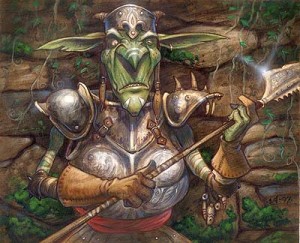 Reason #2: Intro Packs Offer a Lesson in Deckbuilding
Reason #2: Intro Packs Offer a Lesson in Deckbuilding
There are a lot of things Wizards wants to teach you in those 60 cards, and not all of them are obvious. In fact, many of them are quite overlooked! How many land should I have in my deck? How many creatures will I need? How many colours can I play and still have a deck that works? One need only look at the example set by these decks to get some guidance on the rudiments of deck construction.
One occasionally hears the complaint that precon decks act as “shortcuts” to real deckbuilding, as if buying a deck off the shelf retards a player’s ability to disover how to build on their own. It may come as a surprise for some, then, to learn that precon decks are actually designed to do precisely the opposite: they teach deckbuilding through its composition and card selection. Just as Mark Rosewater and Wizards R&D have confessed that they sometimes build “bad” cards to test skill and give players “A-ha!” moments when they reach that conclusion on their own, so do precon decks contain suboptimal choices in their contents.
There are few who would argue that Goblin Piker is a good card. A vanilla 2/1 for two mana, even for the less-than-efficient red that’s a poor deal. How then do you account for his popularity with the intro pack? Just looking at decks in the Standard environment, the bugger has found himself in Magic 2010 (Firebomber) and Magic 2011 (Breath of Fire), Zendikar (Pumped Up) and Rise of the Eldrazi (Eldrazi Arisen).
The answer, of course, is that after a few experiences with his underwhelming presence even the most nascent deckbuilder begins flipping through their cards, looking for something better. Perhaps they open up a Grotag Siege-Runner, Goblin Shortcutter, or Oxidda Daredevil and the lightbulb sputters to life above their head. In short, the Goblin Piker is a bridge, a set of training wheels, a training tool. His lifespan is only so long as it takes a player to learn their first lesson in Good is not as Good as Better.
To them that would callously say, then, that “precons suck,” I would answer that they’re actually quite well-designed for the most pat but serve a specific need. The player looking to snag an intro deck to break out at their local FNM will be sorely disappointed, but the player looking for a good point of entry in a roiling mass of thousands upon thousands of cards lets them dip their toes (or jump right in) when ready. The intro decks have evolved to meet those needs.
Reason #3: They Are a Ready-Made Foundation for Deckbuilding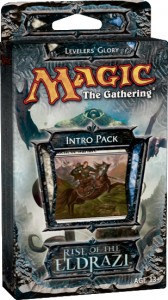
This is similar to #2, except it is aimed at the more experienced player who already knows how to stitch sixty cards together into a coherent whole. In this case the intro pack deck offers a stepstool to the archetype model, giving you a host of the component parts in one convenient package. Been looking to build a Myr tribal deck? You could do worse than to begin with Myr of Mirrodin. How about an Infect package? Pick up a copy of Phyrexian Poison. White Weenie? Splashing together Leveler's Glory from Rise of the Eldrazi with Magic 2011's Blades of Victory ought to give you a reasonable enough skeleton to drape some of your own cards over.
This needn't be confined to the ultra-casual kitchen table, either. Mana Nation's Brad Wojcheshonek has recently begun chronicling his quest to take an intro deck in a respectable competitive direction with his excellent Under Preconstruction series. In short, if you're looking for a quick-build on a midrange deck, you can frequently find Intro Packs a good place to start. If you're looking for more than that, better check out our Spike articles on how to build it, and our Finance section to help defray the cost!
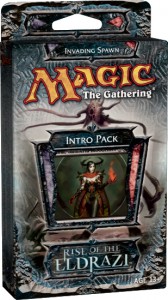 Reason #4: They Provide Grist for the Alternative Formats Mill
Reason #4: They Provide Grist for the Alternative Formats Mill
It's hard to imagine that once upon a time there was no Draft, but it's just as hard to imagine modern Magic without it. From end to end, alternative formats are spectacular for the health of the game. Quite simply, the more and different uses we can find for foil packs filled with fifteen cards in it the better the business for Wizards, and the more the game gets supported.
As I discussed in my article about the Premium Deck Series (Slivers and the Secret of Fire, in case you missed it), cube and Commander are two formats where the appearance of the cards can for many be every bit as important as the cards themselves. Whether it's foreign, foil, textless, or any combination thereof, premium cards of all varieties command premium attention. In guaranteeing a specific foil rare in each deck the Intro Packs have been sought after by some players of these formats. Now if this was all there was to it, it might hardly warrant inclusion on so prestigious a list, but for Commander in particular there is more to the story.
The Commander community has begun to wake up to the fact that Wizards has woken up to the Commander community. While this has culminated in the recent news about the new Commander preconstructed decks this Summer, even leading up to this Wizards preconstructed products have given some consideration to the format. Many decks have leaned towards a wider variety of cards (making them more attractive to the adherents of a singleton format), and many in the Commander community saw Rise of the Eldrazi's Invading Spawn as a gift missing only a bow. With a sharp foil of a Legendary creature (Drana, Kalastria Bloodchief)as its premium rare the deck proved to be amongst the most popular of the lot, its only rival Leveler's Glory due to the foil Student of Warfare.
There is something of a downside to this, of course, and that lies in the tension between a 'good' preconstructed deck and one that's appealing to the Commander set. The ultimate preconstructed product for a Commander player is one that has as few duplicated cards as possible (ignoring for the purposes of this point whether or not the cards are actually any good). By the same token, reduction of variance by repetition of card selection is a characteristic of good preconstructed design (for five more, check out my article about the Five Elements of the Best Precon Decks). Support for singleton formats is a great way to move Intro Decks but Wizards will have to balance this aim with the goal of making quality Intro Decks in the first place. Too much love for singleton formats will erode the quality of the products, but then, this might tie nicely back into Reason #2 and give new deckbuilders something obvious to improve upon.
Finally, we get to the last reason, and for a preconstructed diehard such as myself this is the most important of all.
Reason #5: Intro Pack Decks Serve as Museum Pieces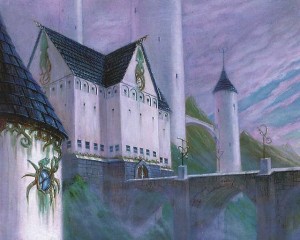
Every year, Wizards of the Coast takes us to a new worldscape conjured from the imaginings of some of the industry's greatest storytelling minds. Add to that a layer of mechanical innovation, with both new gameplay twists as well as versions of past keywords and interactions, and you have a tremendous amount of creativity that has a very short time in the sun. Once a card pool rotates out of Standard, it begins to dissolve into a cluster of noteworthy cards amidst a sea of bulk and background. This is good for the game overall (indeed, it's vital that there be a steady, unceasing march from old to new), but it seems a shame that so much creative effort gets left behind.
Enter the Theme Deck/Intro Pack. Serving as something of a "fly in amber" each of the theme decks encapsulates an element or aspect of the set that the designers want to highlight, and by replaying these decks you have the ability to time travle through Magic's storied past. Want to see what the game was like during Champions of Kamigawa? Urza's Saga? Lorwyn? You could go the expensive way and buy a box of boosters, but for the casual adventurer the precon deck is just the ticket.
Of course quality fluctuates and your mileage may vary, but overall you should be able to get a very good feel for the feel of a set through its decks. I've held up Zendikar as being a very poor example. Its decks were rather crummy, filled with Magic 2010 cards and overall poorly representative of the set. If the designer's tagline was "maps, traps, and chaps," only the latter saw any real focus. "Maps" (quests) and traps went largely ignored.
One need only look at the subsequent block to see improvement, and about the only thing later generations might miss when they come back to experience Scars of Mirrodin through it's intro decks is imprint.
Thanks for visiting the world of preconstructed Magic today. I hope you've enjoyed yourself as much as I have and as always your comments are not just welcomed; they're encouraged! Have thoughts about any of the reasons I've offered? Have a few reasons of your own? Let me know!
And to end with a laugh, I'd be remiss if I didn't include...
Bonus Reason #1: To Support the Developing 'Competitive Preconstructed' Format


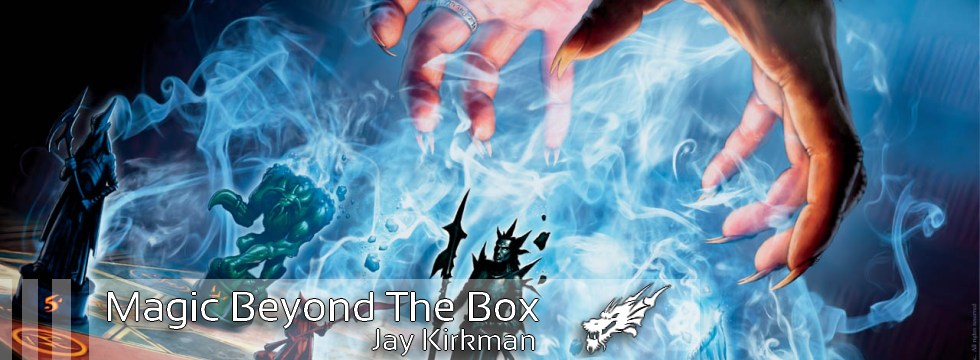



With the ever-increasing push by WotC to get players of all experience levels to their LCS for FNM and other sanctioned events, the one thing that the intro decks DON'T do is give newer players a deck that won't get destroyed.
It can be very devastating to a new player to roll into an event thinking they have a reasonable deck and just get completely shut down — which is a great way to lose players. And with drafting being an even more complex endeavor for most, standard is going to be where many players get their feet wet with tournaments.
It's not that I don't understand a need for true "intro" decks, but I think a better model would be "basic" decks released with each core set and remotely "competitive" decks with the blocks with far less 1 and 2-ofs, some additional rares and tighter themes to build around.
The move to 60 card intro decks is a HUGE step forward from the 40 card decks – but I think Wizards is still having a hard time finding the perfect sweet spot for pre-cons and there's definitely room to improve these products that will suit both beginners and seasoned players alike.
Mike-
Thats a great point, and as Corbin mentioned below the forthcoming Event Decks will be looking to address that concern. I think for the most part, though, you're not going to have a ton of players who are going straight from learning the game to their FNM (though you'll have many!). For learning, these things are at home at the kitchen table, and even the inserts these days have sections written in them that discuss ways to improve the very deck you just bought.
OVer at Ertai's Lament, we have a series called "Ertai's Meddling" which we started during M11. In it, we take a precon deck and using only commons and uncommons (which any new player might have reasonably easy access to), we look to cut out its weaknesses and strengthen it overall.
(continued)
For the M11 decks, these pieces virtually wrote themselves! When we brought that tradition into Scars, it was surprisingly (and refreshingly) tougher going. The decks stuck more solidly to a theme (which was good for most all except the proliferate-centred Deadspread, which didn't have enough pieces to reliably work), had more copies of multiple cards, and so on.
It's probably imprudent to draw conclusions off of just one set, but if Scars is any indication, Wizards is definitely moving in the direction of that 'sweet spot.'
Mike hit on a good point. I wonder if there's a way to get stores to do a precons-only tournament! One of the goals of precons is to expose newer players to a lot of interesting cards that they can play with. The downside, though, is that the players don't get to see the huge advantages of playing a deck with 4-ofs. The materials in the Duel decks even don't cover that you really should mess around with them and try to up the quantities of cards that you like.
Great article, by the way! I really appreciated all the links, it made for a well-researched article and your passion for precons comes through. I especially liked the fly-in-amber metaphor.
Absolutely right about consistency and variance- it's a theme we're constantly banging on about in our precon reviews, but it's the way of things. Once upon a time the decks did have that- Tempest's Deep Freeze packs in a startling amount of countermagic, for example. Somewhere along the way, the theme deck/intro pack became 'repositioned,' and I believe they've suffered for it somewhat.
I can't take credit for the linking- that was my stalwart and intrepid editor, Adam Styborski, who tuned up my piece and made that suggestion. It's a champion one, and I'll be making sure even the very decks have links in all subsequent pieces!
@Mike
They are actually doing this with the new tournament deck series, which they claim you can pick up and be competitive at an FNM. So they are at least attempting to bridge the gap.
All in all, great article! I'm actually introducing two friends into the game right now, and precons would be so much better to teach them the basics than our kitchen-table, million-keyword games. We're getting them their first draft tomorrow in a friendly non-sanctioned environment. Keep up the good work!
I know this is a tad off topic, but don't underestimate the power the the Deck Builder's Toolkit. I unboxed one with a friend the other day and we managed to make two decks that were fairly competitive. My only complaint with the Toolkit is that you can't build a mono colored deck because there are only 20 lands in each color. But we tried. We managed to make a nasty soldier deck (mono white) that was shy on land but had the mana curve to pull it off. Then we built a red/green beat n' burn with some nice fat creatures (including two of the lesser Eldrazi). We had some very fun matches with these decks and the deck building guide included in the box seems very helpful.
Ertai's Lament is the best!!
As a newer player i have to say that starting with a precon deck was what made the different. I started with core 2011 Power of the Prophecy. That gave me a great base on some strategies that work and some that don't. However that deck has evolved into a blue black control deck that drives my friends crazy simply because i have given myself enough ways to win that they can't keep up. So the real drive of the precon is to give them an idea then you need friends to help show you what to do with it, and the rest is just learning the cards and toying with your deck.
This is one of the best written articles I've ever read. Clearly laid out, to the point, and you have a masterful way with words. I really enjoyed the whole read and look forward to your next!
Damning me with faint praise, eh? But seriously, cheers for that, mate, I hope it doesn't disappoint!
Played in the Gatecrash pre-release. Managed to pull a holographic Aurelia, among some other good mythic rares.. . Already have a buyer for Aurelia, but
I’ve read some jusxt right stuff here. Definitely price bookmarking for revisiting.
I surprise how a lot effort you place to makke thnis kind of magnificent
informative web site.
Here is mmy web-site: buy google plus 1 (Grady)
I think everything published was ver reasonable. But, connsider this,
suppose you were to write a awesome headline?
I ain’t suggesting your information isn’t good., but uppose
you added a title that grabbed folk’s attention? I mean Five Reasons Why Intro Packs Matter | Quiet Speculation – Learn. Trade.
Profit. is kkinda boring. Youu might lookk at Yahoo’s front page and watch how they write news headlines
to grab people to open the links. You might trry adding a vieo or
a picrure orr two to grab readers interested about everything’ve got to say.
Just my opinion, it would make your posts a little livelier.
my page; purchase google pplus 1, Joshua,
We stumbled over here different web address and thought I
should check things out. I loke what I see so now i am following you.
Look forward to looking over your web page for
a second time.
Also visit my web page: disability lawyers (Robbie)